The Qualcomm Snapdragon 835 Performance Preview
by Matt Humrick & Ryan Smith on March 22, 2017 4:30 AM EST- Posted in
- Smartphones
- Snapdragon
- Qualcomm
- Mobile
- SoCs
- Snapdragon 835
- Kryo
Qualcomm on Tour: Power, Camera Testing, & More
In any case, let’s talk about the tour itself. A first for Qualcomm, the company has given us a bit of access to show off some of the aspects of their SoCs we can’t easily measure ourselves, or to show off other parts of the Snapdragon platform (such as the software stack) that can’t be empirically measured. Given that Qualcomm has historically kept to themselves and been hesitant to engage with tech journalists, even a limited tour is a notable shift for the company. Not to mention a promising sign that, if nothing else, they better understand that the work their engineers and other staff put into products like the Snapdragon 835 deserves to be in the spotlight as well. The idea that engineering is cool isn’t just a STEM educational platform, but something we at AnandTech experience week in and week out.
Power Lab
Given that Qualcomm’s meeting room for press testing was only setup to test performance and not power consumption, it was only fitting that the company’s tour started at their power lab. Here, director of product management Johnny John had setup a demo comparing the power consumption of Snapdragon 820 versus 835. While the usual caveats apply – mainly, that this was a prearranged demo that we didn’t control – it none the less suitably highlights both the power consumption improvements of 835, and Qualcomm’s direction with balancing power consumption with performance for the new SoC.
For this demo, Qualcomm set up otherwise identical development phones running the SD820 and SD835 respectively. Both were running the same fixed VR workload as an example of a high power consumption task. Since this was a fixed workload, the faster SD835 phone in turn gets to bank the entirety of its advantage in power savings. Meanwhile to measure power consumption, Qualcomm’s power measurement gear tapped into the phones at the battery level, so these are phone-level measurements.
| Qualcomm Power Testing - Device Level w/Fixed Workload | |||
| Power Consumption | |||
| SD820 Reference Phone | 4.60W | ||
| SD835 Reference Phone | 3.56W | ||
The end result had the SD820 phone drawing an average of 4.6W, while the SD835 phone was drawing 3.56W, a power reduction of 23%. Real world use cases won’t be fixed workloads, so the power gains won’t be quite as great, but it shows where Qualcomm’s customers can go in configuring their devices. And indeed, Qualcomm’s own reference devices seem to be tuned a bit more towards power savings than performance, going hand-in-hand with the SoC size reduction that Qualcomm has also gone for with their new SoC. Customers make the final call, but Qualcomm seems to be nudging customers towards using their 10nm gains to curb power consumption more than improve performance.
Graphics & VR
The second stop on Qualcomm’s tour was what they call their Snapdragon Advanced Content Lab. This lab’s focus was on graphics and AR/VR development, though as the polar opposite of a Spartan lab or meeting room, “den of geeks” may be the better description.
To be honest, coming off of CES and GDC, Qualcomm’s advanced content group didn’t have much new to show off. The company is continuing to focus on getting Snapdragon SoCs into VR/AR headsets, and has been producing demos, hardware prototypes, and software toolsets to that end, all of which they have been showing off at the aforementioned trade shows. This is essentially the backend heavy-lifting that Qualcomm is doing to enable devices like the Pico Neo CV that we saw at GDC this year.
Along those lines, the company is also keen on showing off the software side of the equation with their performance profiling tools. The nuances are admittedly more something a developer is going to appreciate than an end-user, but it is a prime example of why the company is eager to brand Snapdragon as a platform as opposed to a processor. In the long run, they expect that software will become a much greater part in defining the overall platform.
Camera Lab
Our third stop was the company’s camera testing lab, which although was primarily demonstrating well-known methods for camera testing, was impressive in scope and price tag (ed: especially to tech journalists who would kill for similar equipment for phone reviews). The takeaway, at a high level, is that Qualcomm wants to show off the rigors of their testing methodology, and that every decision they make with their ISPs and associated software are based on significant empirical testing.
On the photo side of matters, the company has a few interesting tools at their disposal, the most useful likely being their variable lighting system, a pair of massive light cabinets that can generate light at a range of intensities and color temperatures. And though it may sound trivial, as our own Joshua Ho can attest to first-hand, this kind of consistent, systematic testing is not easy to do.
Meanwhile for testing the EIS capabilities of their ISP, Qualcomm has a specialized rig just for shaking phones. The particular ability that makes this rig noteworthy is that it can shake a phone using a pre-determined, tightly timed sequence, so that engineers can go back and see how well their EIS system handled specific motions. The ultimate goal here is to tweak their algorithms to produce good EIS results across a variety of scenarios, so that in average use cases the phone isn’t struggling to stabilize video.
Snapdragon Demo Room
The final stop on Qualcomm’s lab tour was what the company refers to as the Snapdragon Demo Room – which is to say that the company had rolled out a number of experience-based demos to show off various non-benchmark related aspects of their SoCs. This included audio, computer vision, and of course, LTE.
In recent months Qualcomm has been pushing the advantages of higher performance LTE modes, which in turn are the basis of what Qualcomm is branding as Gigabit LTE. The most recent LTE categories are leveraging both carrier aggregation and higher-order QAM modes, namely, 256-QAM. These higher-order modes require greater signal-to-noise ratios to be properly received, but in return allow a signal to carry more data, improving the total throughput of the network. The key point of Qualcomm’s simulations being that even with the tighter requirements of Category 16, it’s useful enough of the time to have a meaningful impact on improving spectral efficiency/reducing network (airtime) loads. Though, as I’m sure Qualcomm is painfully aware, putting theory into practice means getting carriers to upgrade their networks to support higher LTE categories.
One particularly interesting demo, even if things didn’t actually go quite according to plan, was iris scanning/recognition on a SD835 reference phone. Manufacturers have been toying with iris scanning as an alternative for fingerprint unlocking for a bit now, both as a means to remove the relatively large fingerprint sensor from their bezels and to offer a means for unlocking a phone that doesn’t require one’s hands. With the latest rendition of the technology, Qualcomm was eager to show off the improvements in the technology, as well as reiterate its security. The result was something of a wash; the demo worked very well with the product manager, but the phone couldn’t see/recognize my irises consistently enough to unlock the phone (ed: or perhaps Ryan is just soulless). Which this being a prototype, problems are not unexpected, but it’s a reminder that the tech hasn’t had the same number of development cycles as more proven fingerprint scanning technology.
On the flip side of the coin, how well the phone can see the rest of the world is also a subject of interest to Qualcomm. Computer vision/object detection demos aren’t new, but like other players in the industry, Qualcomm is lining up behind the recent advances in machine learning. By being able to efficiently executer (infer) highly trained neural networks, they hope to be able to do things faster and other new things entirely than what traditional computer vision has been capable of doing.
Finally, the company was also showing off their audio efforts, both on the playback and recording sides. On the former, they had an A/B setup between a phone and a dedicated receiver to show off the audio quality of the Snapdragon’s audio codecs and DAC, reiterating that at this point a properly designed phone should be able to keep up with dedicated audio gear for non-audiophiles, even with CD (or better) audio quality. Meanwhile on the audio input side, the company was showing off their improved voice activation capabilities for Snapdragon 835. While speed was hit & miss – both the SD835 and SD820 phones often responded in around the same time – over the day the company had recorded the newer phone as more frequently recognizing the activation phrase than the older phone.
Overall, while Qualcomm can’t easily quantify most of these experiences, it’s exactly these kinds of experiences that the company is wanting to bring to the forefront of the public’s mind, in order to show how Snapdragon is a platform, and to differentiate it from other SoCs. Just how much success they will have at this remains to be seen, but in the long run how successful they are here stands to have a significant impact in how the company’s chip-design arm presents itself to the world at large, and how it advertises its wares.


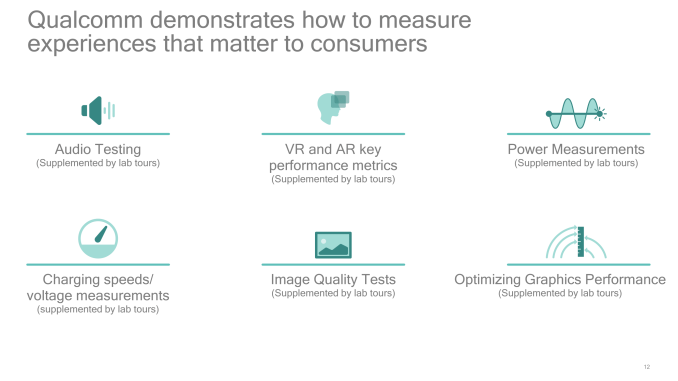
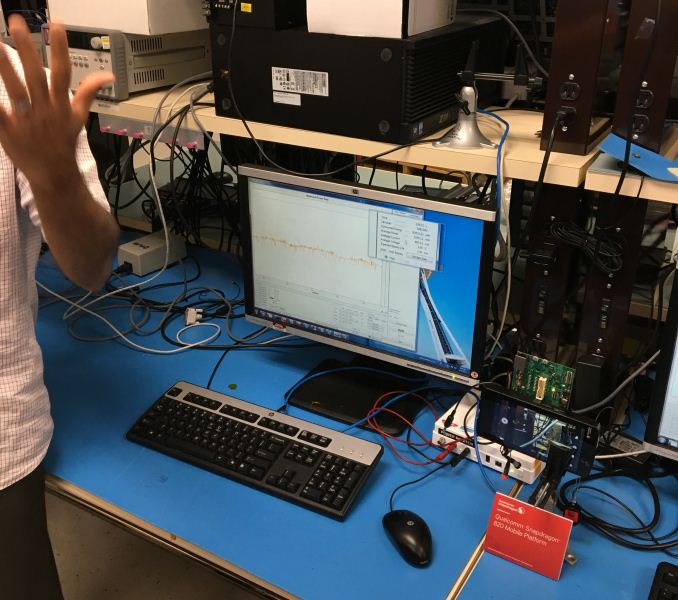
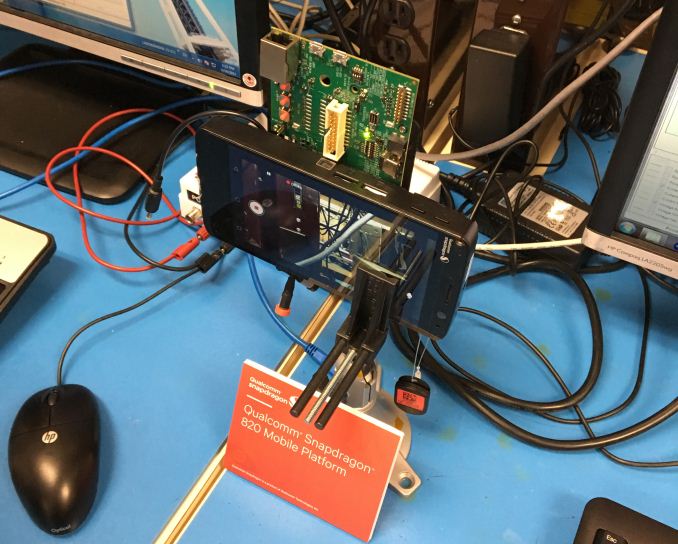

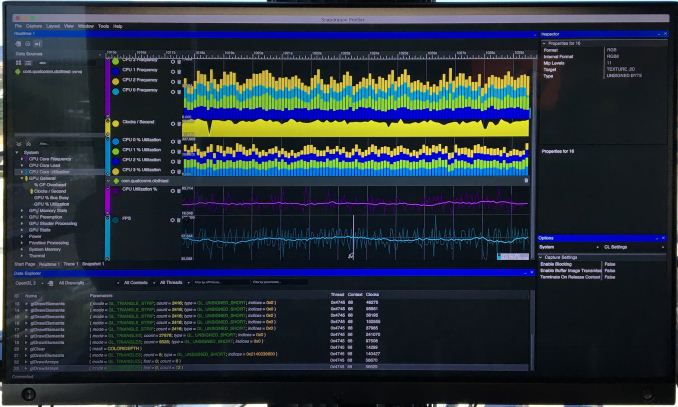

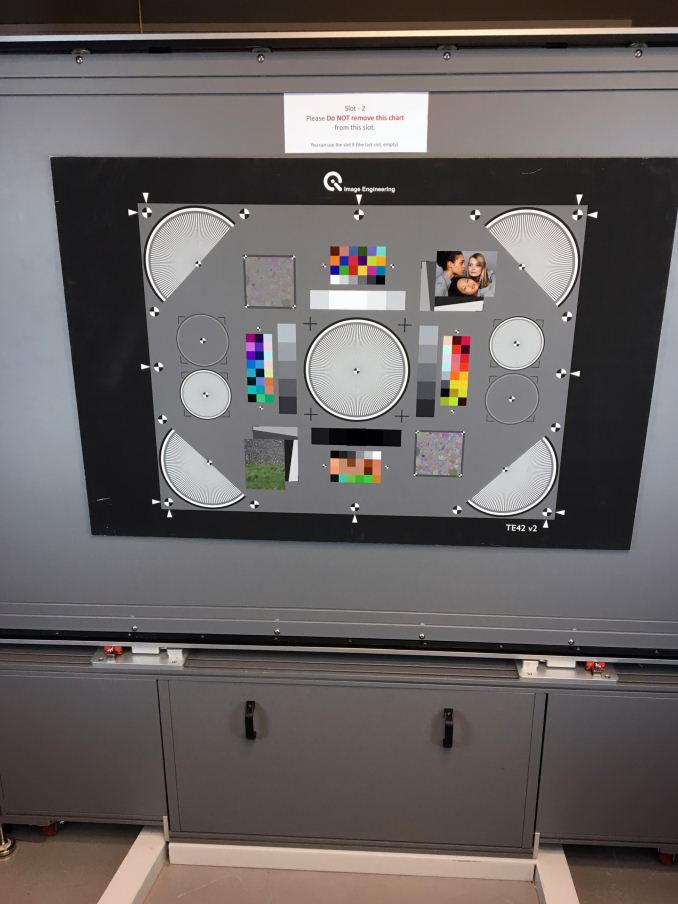





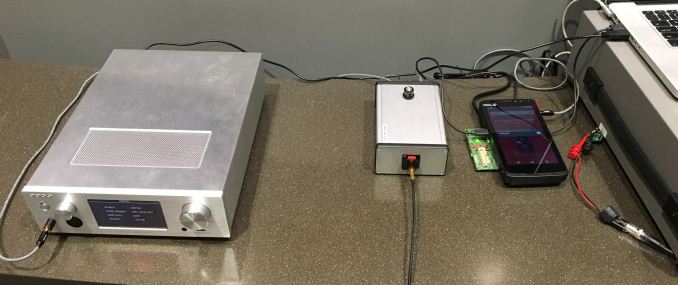








128 Comments
View All Comments
joms_us - Thursday, March 23, 2017 - link
Well not quite 100% to me... Hell knows what background app is making those spikes and not Geekbenchhttp://i.imgur.com/IjBdsOHh.jpg
http://i.imgur.com/6FWmG5Jh.jpg
http://i.imgur.com/IjMsOjIh.jpg
Remember the news about benchmark cheating of Samsung and now Oneplus? What they did are perfectly valid because a worthless app like Geekbench does not measure the true IPC of the SoC if it can't maximize it. You go to Windows world, people will disable CnQ or Speedstep and Powernow just to make sure processor is running at 100% of frequency to measure true IPC.
P.S Thanks for the name of the app, I appreciate it!
realbabilu - Sunday, March 26, 2017 - link
I remember in Windows Pc,is hard to get all cores stay flat at 100% unless I got very good multithread multiprocessor designed program like Ansys or Abaqus. Means its very tough to get/program a software that can utilize all cores stay at 100%.
ah06 - Wednesday, March 22, 2017 - link
Please stop posting, your understanding of SoCs is less than primary school level and you are talking to experts like Andrei........ah06 - Wednesday, March 22, 2017 - link
Why are you on Anandtech? How old are you?Please do not post again
joms_us - Thursday, March 23, 2017 - link
Oh some God from heaven, sorry for stopping by here.lilmoe - Thursday, March 23, 2017 - link
lol, I was literally being sarcastic in my comment. Looks like it stirred a lot of angry replies.- Geekbench does scale well across all cores. That's not the problem. Geekbench sucks as a benchmark for "absolute" performance of the CPU portion of an SoC (or platform like QC likes to call it) that matters for modern workloads. In addition to that, the way it calculates the totals and how the devs decide what sub-score counts more than what is absolute BS. Most of the workloads it tests are rarely dealt with the CPU and more commonly offloaded to co-processors. Yes, even on iOS devices. I find the compute portion of geekbench rather interesting, but it's rarely discussed by anyone.
- CPUs are getting less and less relevant in modern content consumption workloads. Offloading to co-processors, if at all possible, is the way to go. For instance, Intel's latest 7700K CPU (cpu only) pales in comparison to the least efficient 4K encoding/decoding block implementation on any modern platform, including ARM based SoCs. The same goes for image processing/manipulation, audio, speech recognition, security, etc, etc.... You know, the sub-tests that Geekbench performs.
- Interconnect, bandwidth, cache throughput and latency, and Scheduling play a huge part in the multi-core score of a CPU/SoC. Generally, the more cores you have, the harder and more power consuming it is to scale multiple threads across those cores, _especially_ on processors constrained with a 2-4 watt power envelope. Those caches are very power hungry and often limit scaling by 10-20% of ST even on non-power limited CPUs. That percentage is much, MUCH higher on ultra mobile ARM parts.
- In addition to those scaling issues, the Snapdragon 835, similar to Samsung's Exynos and HiSilcon's Kirin SoCs are big.LITTLE multi-cluster configurations. Typically, only 1 of these clusters is high performance, and only when you're running a single or couple of threads would the high performance cores reach their highest clocks. That's by design of ultra-low power, passively cooled parts. The Exynos 8890 gets up to 2.6Ghz in ST and 2.2Ghz in MT. Again, in addition to clock variance, you'll never get 8x ST since only 4 of those 8 cores are high performance. The smaller cores are nowhere near as powerful. I say they would count as Intel's virtual threads in their hyper threading (SMT), and should help to achieve better scaling by just a tiny bit.
So, yea. I was being sarcastic. I agree with Qualcomm. These modern ARM SoCs are very sophisticated and tricky to benchmark. Nothing about them is simple. What ultimately matters is how much time it takes them to complete a modern workload, and how much power they consume at that. The more of these workloads are offloaded to co-processors, the better.
For the CPU portion, what matters in a smartphone/tablet, first and foremost, is multi-core performance, and how much of that performance is sustained over time with the least amount of power consumption. ST performance is overrated doesn't matter, AT ALL, after a certain performance threshold IN MOBILE DEVICES. Split second javascript gains as a result of browser optimization or real ST lead of a particular SoC are irrelevant. Javascript doesn't exist in a vacume, it's part of a web page/app, and how long it takes a browser to fully load a page and render its content is what ultimately matters. Period.
tuxRoller - Thursday, March 23, 2017 - link
"I find the compute portion of geekbench rather interesting, but it's rarely discussed by anyone."Why is that the case?
Btw, this is a much better comment.
What you are saying is why relevant benchmarks don't exist for mobile devices (sub-laptops).
The issue, i believe, is that sites, largely, test these devices like small computers (bear with me). As such, they focus on cpu related tasks. Some sites include video recording/playback power usage, but none, tmk, include task traces that are taken from someone actually using a device.
tuxRoller - Wednesday, March 22, 2017 - link
If all you care about is a running a headless server that can't communicate with the outside world, then, yeah!If you care about battery life and good performance, low power processors (microcontrollers or tiny a series cores used for handling interrupts or more general duties when in a low power state), dsps and gpus matter.
Do we need a hashtag?
prisonerX - Wednesday, March 22, 2017 - link
Yeah those graphics co-processors, what a joke.wardrive2017 - Wednesday, March 22, 2017 - link
Again I am impressed by the Snapdragon 625 showing here in the cpu tests, particulary in the PC mark tests, not so much in the Javascript. Still performing much better than expected. The G5 plus is starting to look quite appealing assuming its tweaked the same ways the Moto z play is